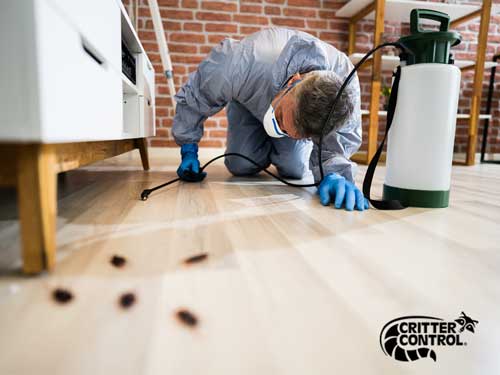A1 Bed Bug Exterminator Charlotte - Specialized Bed Bug Removal
A1 Bed Bug Exterminator Charlotte - Specialized Bed Bug Removal
Blog Article
Bed Pest Treatment Failure: Comparing Chemical Vs. Non-Chemical Solutions
In the world of pest control, particularly when dealing with the relentless issue of bed pests, the selection in between chemical and non-chemical treatment services can be a crucial one. Both methods supply distinct benefits and drawbacks, affecting elements such as performance, safety factors to consider, and general price. By analyzing the nuanced details of each method, a clearer understanding of which course to go after in attending to a bed bug infestation can be obtained.
Efficiency of Chemical Treatments
Chemical treatments for bed insect infestations have been widely recognized for their rapid and potent efficiency in eradicating these parasites. When considering the effectiveness of chemical treatments, it is important to comprehend that they can give a thorough and quick service to a bed pest issue. Specialist pest control men frequently rely upon insecticides to target bed pests at various stages of their life cycle, including grownups, nymphs, and eggs. These chemicals normally function by interrupting the bed insects' nerve system, resulting in paralysis and eventual fatality.
Additionally, chemical treatments have the benefit of using residual impacts, meaning that they can continue to remove bed bugs also after the initial application. This recurring action is specifically valuable in combating any kind of prospective re-infestations. Additionally, the quick action of chemical therapies can bring alleviation to individuals facing severe bed pest problems, permitting them to gain back control of their living spaces quickly.
Safety Worry About Chemical Solutions
One crucial facet that requires careful consideration when making use of chemical solutions for bed pest therapy is ensuring the safety of owners and the atmosphere. Exposure to particular chemicals utilized in bed pest therapies can lead to respiratory system problems, skin irritability, or various other unfavorable responses, specifically in individuals with pre-existing problems or sensitivities.
In addition, the environmental influence of chemical options is one more considerable factor to consider. Some pesticides utilized in bed bug therapies may be harmful to helpful insects, wild animals, and communities if they seep into the dirt or water systems. It is important to use chemical treatments sensibly, complying with security guidelines, and taking into consideration much less toxic choices to minimize these threats and make certain the efficient and risk-free management of bed bug invasions.
Benefits of Non-Chemical Methods
Thinking about the potential safety and security worries and environmental effect associated with chemical remedies for bed insect treatment, discovering non-chemical methods presents an encouraging choice with a number of distinct benefits. Non-chemical treatments special info are environmentally pleasant, as they do not contribute to air or water air pollution, making them a sustainable choice for parasite control.
In addition, non-chemical options can be efficient in targeting bed pests, including hard-to-reach locations where chemical therapies may not penetrate - A1 charlotte bed bug exterminator. Methods such as heat treatment, vacuuming, steam cleansing, and cushion coverings give thorough obliteration without the use of damaging chemicals.
Limitations of Non-Chemical Treatments

Furthermore, non-chemical treatments typically need several applications to accomplish effective removal. This can be lengthy and may not constantly guarantee full elimination of all bed bugs have a peek here and their eggs, especially in hard-to-reach or concealed areas.
Additionally, the success of non-chemical treatments greatly depends on proper execution and thoroughness, which can be testing for people without specialist knowledge. Insufficient application of non-chemical methods may result in incomplete obliteration, bring about persistent problems and the requirement for extra therapies.
For that reason, while non-chemical treatments have their advantages, it is important to recognize these restrictions and consider them when identifying one of the most efficient strategy for handling bed bug problems.
Cost Contrast: Chemical Vs. Non-Chemical Options
Offered the restrictions linked with non-chemical treatments, a crucial facet to examine in the context of bed pest monitoring is the expense contrast in between chemical and non-chemical options. In comparison, non-chemical therapies like heat treatment or heavy steam can be a lot more costly, with expenses ranging from $1,000 to $6,000 for an entire home. While the first price of chemical treatments might seem lower, multiple therapies may be called for to fully remove the problem, potentially increasing the general expense.
Conclusion

Considering the possible safety and security concerns and environmental influence connected with chemical services for bed insect treatment, discovering non-chemical methods provides an encouraging option with numerous distinct advantages.Provided the limitations linked with non-chemical therapies, an essential facet to evaluate in the context of bed pest management is the expense comparison between chemical and non-chemical options. In contrast, non-chemical treatments like warmth therapy or heavy steam can be extra costly, with expenses varying from $1,000 to here $6,000 for a whole home. While the first price of chemical treatments might seem lower, multiple therapies may be called for to fully get rid of the invasion, possibly boosting the general price.In verdict, when contrasting chemical and non-chemical bed insect treatment alternatives, it is necessary to think about effectiveness, security, advantages, constraints, and expense.
Report this page